Still rubbing sleep out of eyes, we were driven to the airport for the 1 hour flight in a 6 seater Cessna to Canaima. Gidi, Karin and myself were joined by Jean and Brigitte, a French guy and German girl, to complete our small group. The flight was great fun - although something akin to flying in a pedalo, the views afforded were excellent as we crossed huge areas of land flooded by the Orinoco river, then went over huge unbroken stretches of jungle before descending to Canaima as the first tepuys came into view.

En route to Canaima
Canaima sits on a lagoon formed below a series of waterfalls on the Carrao river - there is a beautiful white sand beach and palm trees grow in the water in one of the iconic images of Venezuela. The water is a deep red colour but not too cold, and the setting has allowed Canaima to become the centre of operations for visiting Angel Falls, 70km south east up river. There is a wide variety of accomodations in Canaima, but being backpackers we had the cheapest included in our tour - hammocks. After a short swim under the searing sun and a slow lunch, we were taken by small boat across the lagoon to view the impressive waterfalls close up before landing and walking over to 2 smaller waterfalls on another brach of the river. Here, at Salto Sapo we were able to walk behind the waterfall before going for a swim in a natural pool above the waterfall (no gap big enough to be washed over!) - I was burnt already.
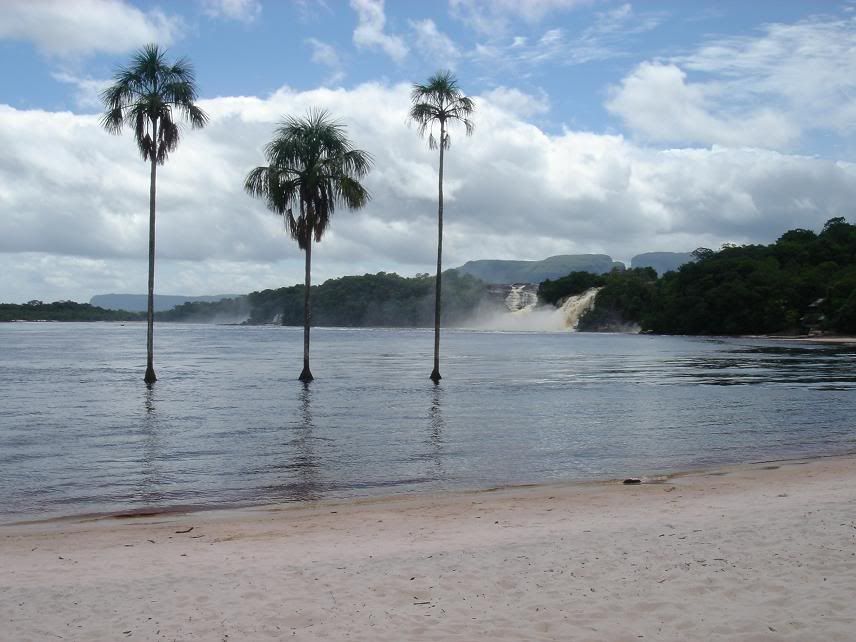
Canaima lagoon
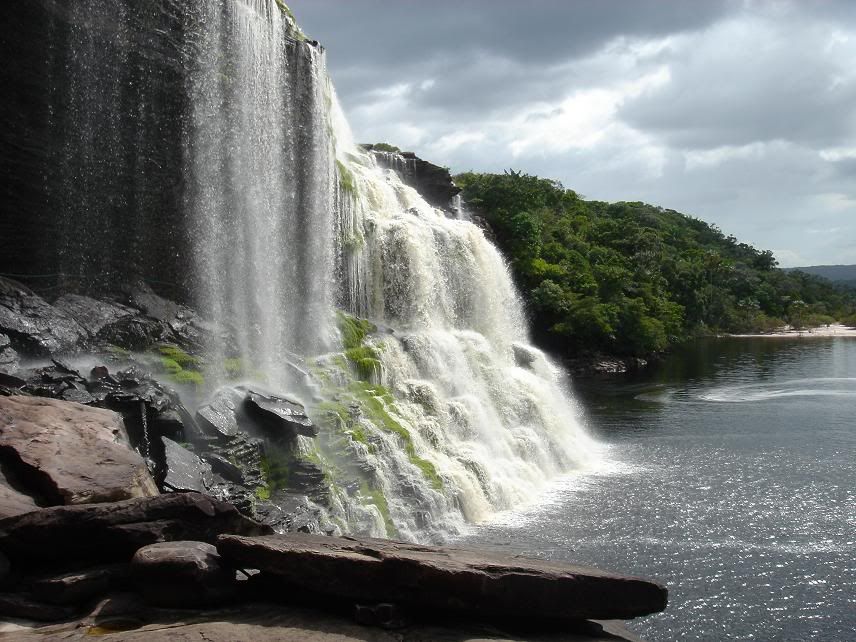
Salto Sapo
After that we were on our boat, a long thin outboard-powered dugout, and racing upriver. We disembarked briefly to walk around the Mayupa Rapids ("No tourists have been allowed over since the accident" our guide said knowingly) before rejoining with our crew and baggage and continuing on. Here the Carrao is wide and slow, bordered on both sides by dense jungle with occaisional Indian villages on the banks. I found the ride tranquil and calming, skimming over the water that seemed to glow with a metallic sheen. After about an hour an a half we pulled into our camp for the first night at Ahonda River. Here was a huge barn-like structure capable of housing at least 80 tourists in hammocks - but we were along apart from the staff, our crew and young American guy.
The sun set in a short blaze of red glory over the tepuy surrounding the camp. The Auyan tepuy is the largest tepuy, in terms of surface area, surrounded us even here, and I was at a loss to orientate myself with its vast walls. We settled down to a quiet night in our hammocks, but the rain started not long after, and drummed on the corrugated roof all night long.
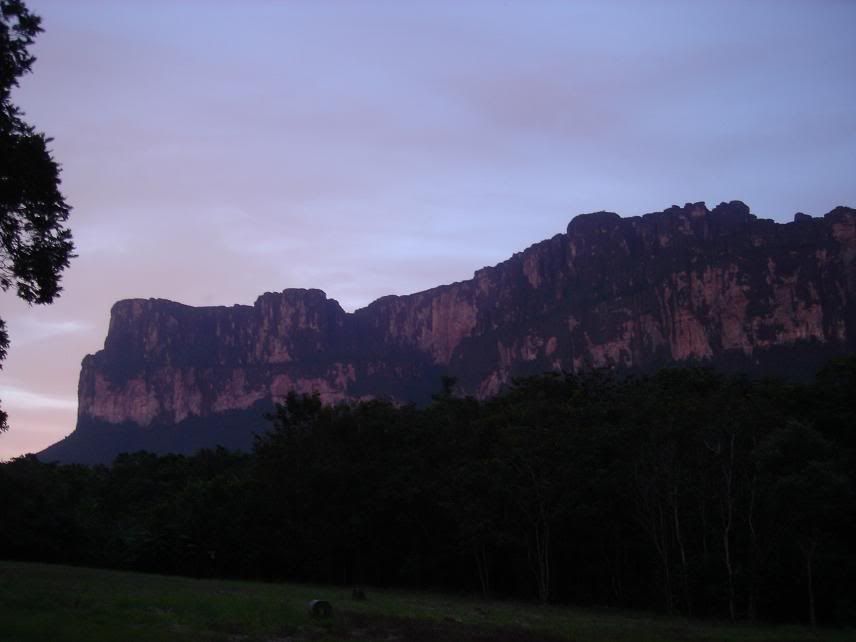
Sunset, Aonda camp
The next morning we were up early and headed upriver again, taking the Churún river up the Devils Canyon. This river was a lot smaller and shallower, and we made slow progress against the many series of rapids that we negotiated. Despite it being the rainy season, rain this year is in short supply; the lowering clouds failed to fulfill their promise (the downpur of the night before was "nothing") and the low water level hampered our efforts to progress. The terrain became more varied and vast boulders lay across the river in places, islands of rock amidst the riot that was the jungle.

Jungle camp
We got to our camp just before lunch and set up our hammocks and went for an explore around; it was a "basic" camp (I'll leave the facilities to your imagination) but was much smaller than our previous and bang in the middle of the jungle - great. We marked the spot in camp from where you could see the Angel Falls, still obscured by cloud at that time. After lunch we set out on the hour long walk to see the falls, and instantly became soaked with sweat in the humidity and heat.
The Angel Falls were "discovered" in 1935 by American airman and explorer Jimmy Angel - he later crashlanded his plane on top of the tepuy, and the falls were then named after him. They rate as the highest single drop of water in the world at 983m, from a trickle in dry season to a full-fledged fall in the wet season. The tepuy landscape, as I have mentioned before, is perfect for waterfalls, and there are literally hundreds in the area; as always though, the biggest is the most popular.
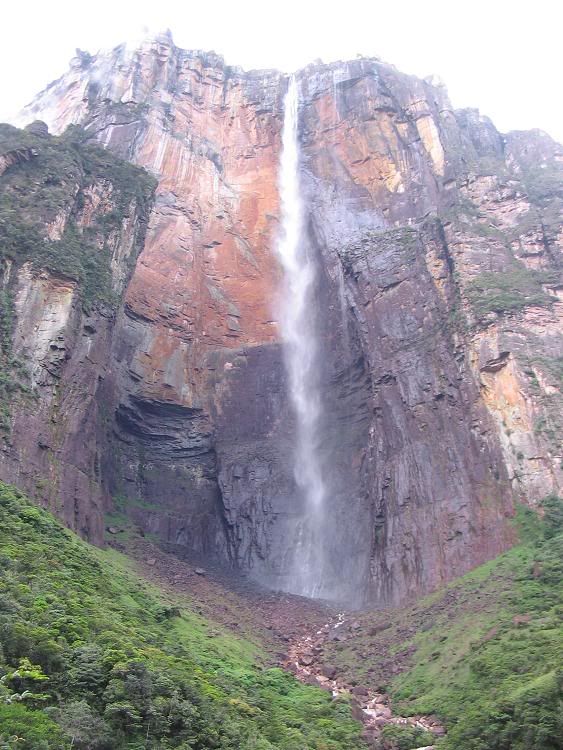
Angel Falls
We reached the mirador and started taking photos - as everyone does. The top of the falls were invisible and it was difficult to gauge the scale of the falls - until a Cessna flew over somewhere close to the top, and looked really small. There is always a danger at these places that so long is spent looking through a lens that you fail to appreciate the beauty with your own eyes - but fortunately we had time and space; there seemed to be no-one else around. The falls were not huge, despite it being the rainy season, but as they collected on the rocks at the bottom they formed a second smaller fall into a natural pool.
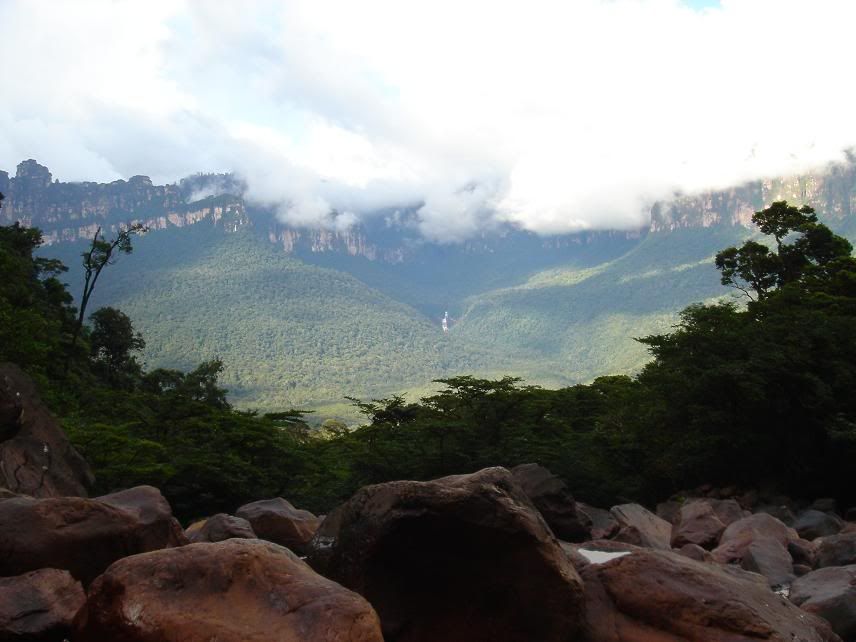
View from the pool
We walked down to the smaller fall and pool to go for a swim - we were incredibly fortunate to have the icy-cold pool to ourselves. As hypothermia set in we climbed out and admired the stunning view across Devils Canyon to another part of the tepuy, lower slopes cloaked in jungle and glowing in the sun. The top of the tepuy cleared of cloud and we suddenly had excellent views of the whole fall; once again, good fortune was with us. We made our way back to the viewpoint and took in the view again before returning down the path - passing a small hoarde of tourists coming up.
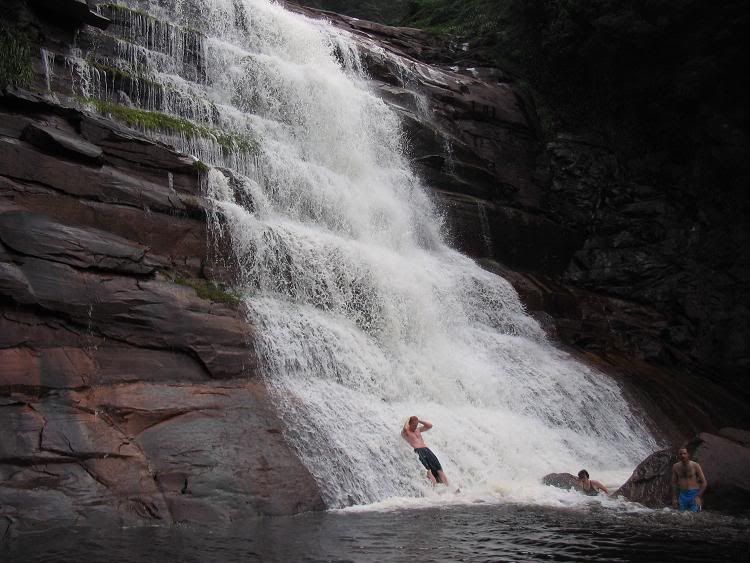
Swimming at the bottom
Walking back through the jungle was fabulous; there is something about the stillness and quiet inside any kind of forest that makes me feel both instantly at home and very curious about my surroundings. I slowed up my pace and wandered back in a kind of state of meditation.
Back at camp we only had a short time until the rain struck - this time is was a genuine downpour that lasted several hours and we ate our dinner under the palm leaf shelter as rain pounded the ground all around. It was still raining as we went to bed.
Early the next morning we were up and back in the boat, hurtling downriver with the current, and reached our camp of the first night for breakfast before continuing on. We got back to Canaima just before lunch and made our home in the hammocks in the camp of our tour company. We had chosen to stay an extra day in Canaima for a possible flight over the falls and a bit of beach time. After lunch we arrange with our guide to go walking behind Salto Hacha, a much larger fall than the previous Salto Sapo we had walked behind. The weight of water thundering down just feet from us was awe-inspiring, and we sepnt almost half an hour exploring the area behind the waterfall that could usually only be reached in dry season.

"Behind this?"

Back at camp, and Gidi and Karin discovered that they had had some money stolen at some point during the trip. It put a real dampener on the trip, not in the least because the tour company seemed indifferent, unlike our guide and the younger member of our boat crew, who were both very concerned. Over the course of the evening (dinner was cooked on an open fire) and the following morning Gidi and Karin tried hard to get a copy of the Police report without success (whilst I basted myself in the sun on Canaima beach). Only as we were elaving, and Gidi and Karin refused to get on the plane with a copy of the report, did things happen - but we all knew the chances of seeing the cash again were nil.

Sunset over Canaima lagoon
Back in Ciudad Bolívar we went to the original tour agency who we had booked with - they contracted out their Angel Falls tours to a cheaper bulk operator (you pay backpacker prices, you get backpacker tours....). Whilst overall very happy with the experience the theft was clearly a large negative point. Luis, the manager of the agency, was a lot more concerned and believing than those in Canaima - to the point that he reimbursed the money stolen. Gidi and Karin (and all of us) were genuinely lost for words at the act - it made a very good impression.
That afternoon Gidi, Karin and myself took a bus to Puerto La Cruz, on the Caribbean coast. After not stopping for 10 days we felt a bit of beach time was in order - and I was due to meet Hannah in just 6 days in Lima. I had already arranged the flight from Puerto La Cruz to the capital Caracas, from where I would catch a flight to Lima - avoiding the capital by taking a flight in and out on the same day seemed like a sound idea.
We arrived in Puerto La Cruz at night - never a good idea - and spent over an hour trying to find a reasonably priced hotel with hot water. Eventually we did, and watched our cable TV and took scalding showers until the small hours. Puerto La Cruz, formerly beachy tourist town, has evolved into a major oil refining town and seemed over priced and without an attractive beach to help matters. The morning after we decided to leave for Mochima, a coastal national park to the east, as soon as we had got money out and sorted out CDs. It was very hot and wet in Puerto La Cruz; even in the rain I could feel myself sweating as we tried various banks to get out money.
By the afternoon however we were happily in the tiny town of Mochima, in an entirely different atmosphere. It was laid back to the extreme, and although had no beaches, it did have a series of beautiful waterfront restaurants and a plentiful supply of small launches ready to take us to the beach of our choice.
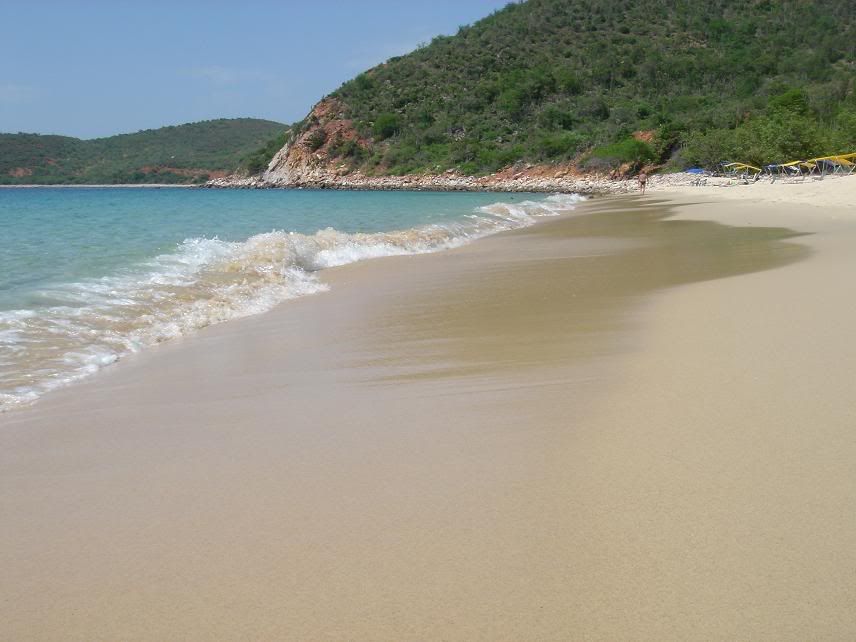
Cautaro beach
The morning after the weather was excellent and we took a boat out to a quiet beach, past the popular main ones. Here the warm clear blue water of the Caribbean gently washed against the white sand of Cautaro beach as thousands of brightly coloured butterflies moved like cherry blossom in the wind, and we lay in silence, still recovering from Roraima and Angel Falls.
The National Park in the area covers a series of small islands, hundreds of tiny white sand beaches, and areas of coral reef. We took a tour the following day around that park, equipped with snorkelling gear, and in the company of a friendly Venezuelan family on holiday. It was a good day - the coral was some of the best I have ever seen, we spotted some dolphins, and got to visit several more remote beaches. And I didn't get sunburnt, thanks in part to my rash-vest that I was finally using after months of carrying it in my rucksack.
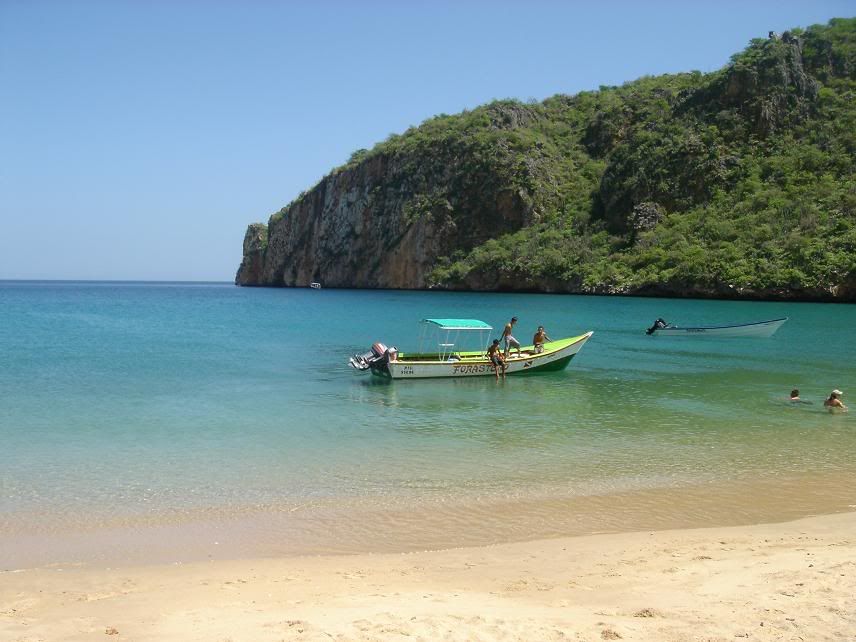
On the beaches tour
My last full day in Venezuela (or so I thought....) was as unplanned as the next. The weather was poor and we headed into Cumana, a small city further east, for a look around and to find the ever present Internet cafe. I reconfirmed my flight with TACA from Caracas to Lima, Peru, for the following day - I would arrive almost 24 hours before Hannah. Gidi, Karin and myself enjoyed a last evening together before I set off across to the other side of the continent the next day to meet Hannah.
There is an expression, I think, "Even the best laid plans can be laid to waste". I left Mochima early to get to Puerto La Cruz, from where my flight would depart for Caracas. I reached the airport with hours to spare, and began the long wait for my flight - I was due to arrive in Caracas 4 hours before my other flight. Despite the Arrivals and Departure boards reading everything normal, planes seemed to be failing to arrive from Caracas. My flight didn't arrive - I could see my bag on the tarmac - and I went in search of information. Concisely put (the Venezuelans were anything but) the power was out in the National flights terminal of Caracas airport, but the International terminal was functioning 100% fine. There was nothing I could do but wait, and hope.
I arrived in Caracas 4 hours late, just as my other flight was taking off. Seriously aggravated, I set about trying to sort out a flight - afterall, I had a girlfriend to meet. My initial attempts hit brick walls - "You can fly with Aeropostal - but they're not going today" and "Yes, we have seats for this evening, only 800 dollars....". With the help of a kindly TACA employee and an even kinder airport employee I found myself on the toll-free number to TACA, where they transferred me, for free, to the flight on the following day. I was overjoyed - only arriving 2 hours after Hannah.
I arranged a hotel in a less than salubrious area close to the airport, and settled in to wait until my flight the next day - even as, in a city I had never been to in the south of Venezuela, someone was using a clone of my credit card to withdraw money.
There's always something.

1 comment:
I'm a Venezuelan and I'm so happy to see this in your blog. You choose the best places to be here in Venezuela. Of course there is a LOT more. Your photographs are gorgeous, breathtaking. I've been there in Canaima and I love it.
Post a Comment